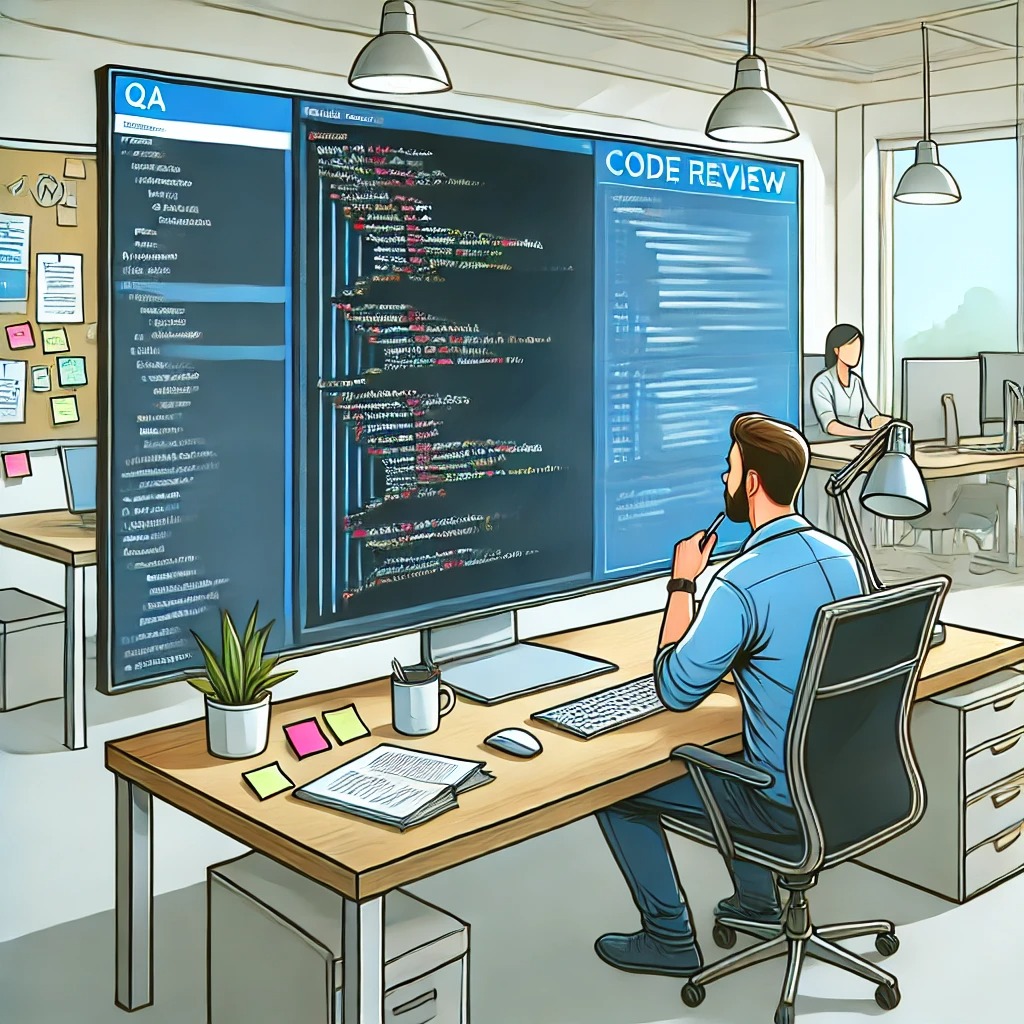How Code Reviews Help QAs
|
|
Today, a Quality Assurance (QA) person is no longer just a test executor but has transformed into a cross-functional, proactive engineering partner. QA in the present day is not simply discovering bugs after something has been developed; instead, it is avoiding them until they happen. One of the most effective contributions QAs can make towards this goal is to engage in the code review process.
While code reviews were once a technical ceremony for developers, they’ve emerged as a collaborative quality gate. Including QAs in these reviews will drive the quality from a holistic viewpoint and also make sure that it aligns well with the business requirements, along with making the code more testable/observable. It all reads into how code reviews benefit QA testing work, and what value one gets when QAs are involved in the process, and what (soft) skills they have to possess to achieve the desired.

| Key Takeaways: |
|---|
|
What is Code Review?
Code review is the systematic examination of computer source code intended to find and fix mistakes overlooked in the initial development phase, improving both the overall quality of software and the developers’ skills. Code reviews are based on the use of pull request workflows, such as those used in GitHub, GitLab, or Bitbucket platforms. Some of the main objectives of code reviews are:
- Maintaining code quality
- Catching bugs early
- Promoting knowledge sharing
- Enforcing coding standards and architectural guidelines
However, the goals are broadened when QAs participate in the procedure. The perspective changes to include quality views like how well the final product met the customer requirements, risk assessment, potential customer impact, and test coverage. QAs should contribute value to HOW we review the code and bring some perspective on how businesses expect things to work for the end user.
Code Review in Software Engineering: QA’s Role
The nature of what QA teams need to accomplish has changed tremendously over the past years, from mere bug detection to enabling a level of development expertise through the entire software engineering lifecycle. This transformation, moving from a reactive role to a strategic, proactive position, has changed how QAs impact quality, work together, and the speed of delivery.
Code Review Process: From Reactive to Proactive
There was a time, to be fair, when QAs tested post-deployment and found bugs after software achieved a certain level of stability. That model worked, to a point, but it had a few problems: It caused delays and higher defect costs. It frequently led to combative relationships between QA and development components of the organization.
The agility and DevOps revolutions introduced new paradigms such as continuous integration, deployment, and test automation. So, it began that QAs got involved sooner in the software development cycle, moving left, so to speak.
Key Aspects of the Modern QA Role
- Story Analysis: QA testers verify acceptance criteria and expose ambiguities in stories early in development to make sure that user stories are well understood and testable. Read: Acceptance Test Driven Development (ATDD).
- Automation Strategy: Design and implement effective automated testing pipelines for accurate and fast feedback on code changes.
- Exploratory Testing: QAs look further than the script (for issues) to check for unexpected behaviours, etc., this is what we call exploratory testing. Read: How to Automate Exploratory Testing with AI in testRigor.
- Security and Performance Awareness: They proactively identify security vulnerabilities and performance bottlenecks, ensuring the software is not only functional but also robust and secure. Read more: Security Testing.
- Code Reviews: QA Engineers actively participate in the code review process by checking logic, catching edge cases, and also making suggestions to increase testability and general code quality.
In this paradigm, QAs are ‘quality coaches’, working closely with developers, product owners, and operations to make sure that every step of the SDLC is geared around business value and user needs.
The Value of Code Reviews for QA Professionals
Engagement of QA experts in code reviews empowers them to provide their valuable feedback at the early stage of the development life cycle. This paves the way for all the participants in quality and test strategy. Such visibility of the code just helps QAs in understanding the specific implementation so that they can design intelligent test cases to meet business/user expectations.
Early View into Implementation
QAs get an early look at how features are being developed by being part of code reviews. It enables them to tune the test plans before the development is finished, to the hot spots before they all get broken, and to the areas where the risk was just too high, and the requirements too fuzzy, before they get implemented. The earlier QAs are involved in implementation, the more it increases the proactivity and effectiveness of their testing.
Better Test Coverage
Code reviews also help QAs to get to know the branching logic, edge cases, and conditional work flows, which are something hard to understand directly from the requirement itself. Based on this enhanced understanding, the QA can create better and more focused test cases that target high impact areas. It assures that automated and manual tests match the actual behavior of your code and not only the documentation.
Validation of Business Logic
QAs are the last and most critical gate to meeting business needs and code production. When it comes to reviews, they focus on whether the code faithfully understands the acceptance criteria and handles edge cases realistically. Their feedback prevents customer needs and technical execution from remaining misaligned.
Promotes Code Testability
Code that is difficult to test can result in low coverage and brittle automation. QA reviewing code can ask if components are modular and their interfaces are clearly defined. Their input is driving development toward writing code that is more easily tested and maintained to reduce long-term QA effort.
Improves Observability and Debuggability
Good observability is essential for debugging problems in production. QAs can make sure during their reviews that logs are useful, exceptions give information, and that APIs return human-friendly errors. Having correct telemetry in place helps us to solve the post-deployment issues quickly. Read: Decrease Test Maintenance Time by 99.5% with testRigor.
Reinforces Security, Accessibility, and Compliance
QAs play a role in protecting important aspects such as security, accessibility, regulatory requirements within a code review. They have flagged weak validation logic, credentials exposed, or inaccessible features (like ARIA attributes not being present). This proactive engagement helps us to supply secure, accessible, and legally compliant software.
QA Review vs. Developer Review Mindset
Developers usually focus on code performance, layout, and design patterns when they review. While QA approaches reviews from a functionality, testability, and alignment with user expectations perspective. Such divergent viewpoints are complementary and together give more powerful and versatile software.
| Developer’s Focus | QA’s Focus |
|---|---|
| Code correctness | User scenario correctness |
| Performance and efficiency | Risk-based prioritization |
| Reusability and maintainability | Edge case coverage |
| Conformity to technical standards | Conformity to business logic |
| Refactoring opportunities | Testability and traceability |
These different mindsets create a well-rounded review environment when both roles collaborate.
Code Review Best Practices for QAs
QA engineers should have strategies, but at the same time, align the review process with their skill set and the team’s development practices. You don’t need to be a coding guru, but a little bit of preparation can help when it comes to providing usable feedback. Below are a few tips that can help QAs review with confidence and contribute to the code quality.
Understand the Repository Structure
QAs need to start with the codebase and then understand where business logic, APIs and UI are defined. This helps reduce review time, because we know how files and branches are named and where unit, integration, and end-to-end tests are located. This basic information helps to avoid confusion and accelerate the gap discovery process.
Develop a Personal Review Checklist
Being able to have your own list really helps QAs to be more consistent and focused during reviews. Actually, that’d probably also include checking against acceptance criteria, error logging, meaningful levels of test coverage. It also provides some structure to every review, and keeps the important quality factors from being forgotten.
Structure Feedback Effectively
Feedback from QAs needs to be transparent and respectful, focused on quality improvement. It is better to ask a question than to make an assumption, to have a healthy discussion, and to understand each other better. Keep the review focused and collaborative with references to requirements or expected behavior.
Overcome Common Barriers
It isn’t always easy to bring QAs into code reviews, and there may be practical or cultural pushback. With the right attitude and a team on your side, these obstacles can be overcome to derive all of the benefits associated with QA involvement.
- Perceived Lack of Technical Depth: QAs might be more reluctant if they have little coding experience, as their job is checking intent and code quality. Promoting learning and teamwork will build confidence over time.
- Resistance from Development Teams: Initially, some developers might feel like their QA is getting in the way. By being open and transparent about the role of QA and the added benefits of embracing the role, there will also be a better likelihood of acceptance and collaboration in general.
- Time Constraints and Workload Management: Fast sprints can add pressure to code reviews. Focusing on high-risk areas and sharing review responsibilities with the entire QA team can help break down the work into bite-sized pieces.
Prerequisites for QA Participation
In order to be capable of an active role in code reviews, QAs should have basic knowledge about code, how a version control system works, and how testing frameworks are used. These support skills don’t necessitate knowing how to code at the level of a pro, but they do necessitate an ability to understand a few lines of programming enough to draw conclusions and to communicate with developers.
- Foundational Code Literacy: QAs don’t have to write production-level code, but they should be familiar with simple programming constructs such as loops, conditionals, functions and handling errors. They know the syntax of test cases and the typical patterns in unit tests or API tests so they can follow logic and find missing tests. Tutorials, pairing up, or team workshops can gradually build up this literacy.
- Familiarity With Version Control Systems: QAs should also be able to get themselves around pull requests, read through code diffs, and work their way through commit history. They can also review the right changes and the context by knowing how branches are utilized and merged. These Git skills also bring QAs closer to developer workflows and review.
- Awareness of Testing Frameworks: QAs are better off knowing the project’s used testing tools, like testRigor. This enables them to assess if we have meaningful and adequate tests, and to identify missing or flaky cases. Knowing your testing tools eliminates the gap between test design and test implementation.
Benefits of QA Participation in Code Reviews
It is of great importance to have QA participation in code review with respect to the team culture and the product in general. Their fresh perspective enables them to catch issues early, identify opportunities to optimise, and maintain a culture of shared responsibility and continuous improvement.
- Improved Team Alignment: QA participation encourages teamwork between developers, testers, and product managers. It also provides a common understanding of the features and expectations. It helps minimize handover gaps and cultivate collective responsibility for quality.
- Reduced Defect Leakage: Early QA feedback in the code review stage prevents bugs from advancing to QA tests. This proactive approach significantly lowers the number of repeated issues and rework. Read: What is Defect Leakage in Software Testing?
- Enhanced Sprint Efficiency: Early validation of code logic and test coverage helps speed up sign-offs and reduce last-minute surprises. This is why teams enjoy shorter feedback loops and their test environment is more steady.
- Cultural Maturity and DevOps Alignment: QA attending reviews signals a mature engineering culture where everybody owns quality. It’s DevOps by design, because testing is part of continuous feedback.
Conclusion
Code reviews provide QAs with a fantastic place to shift left and step forward to take a more proactive position regarding product quality. Their participation aids in identifying possible problems before they become defects and in refining the implementation to match what the user wants. Of course, QA helps drive better testability, observability, and long-term maintenance of the code. The resulting cross-functional collaboration results in better attuned implementation and user-friendly applications.
| Achieve More Than 90% Test Automation | |
| Step by Step Walkthroughs and Help | |
| 14 Day Free Trial, Cancel Anytime |












